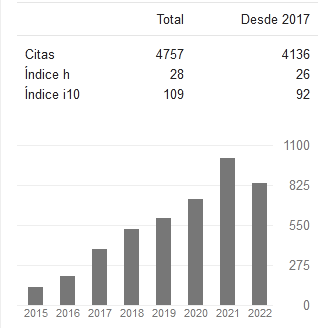LESIONES MÁS FRECUENTES EN EL MANGUITO ROTADOR. FACTORES DE RIESGO Y TRATAMIENTOS EFECTIVOS
Palabras clave:
Manguito Rotador; Lesiones; Tendinopatías; Fisioterapia.Resumen
El dolor de hombros afecta a un número sustancial de adultos, y este dolor se debe en su mayoría a lesiones en el manguito rotador, el conjunto muscular formado por los músculos supraespinoso, infraespinoso, redondo menor y subescapular. Las lesiones más reportadas en la literatura son las tendinopatías que afectan las estructuras subacromiales, la tendinitis calcificante y las roturas o desgarros. Se han descrito diversas actividades laborales y factores de riesgo que tributan a la aparición de lesiones en el manguito rotador con mayor frecuencia, e incluso se plantea que existen mutaciones en diversos genes que están involucradas en la aparición de las lesiones, así como una cierta predisposición genética para sufrir esta afectación con mayor probabilidad. Este problema en los trabajadores puede causar ausentismo laboral y pérdida de la productividad, lo que lleva a importantes costos económicos y sociales. Los medicamentos antiinflamatorios no esteroideos, ejercicios de rehabilitación y fisioterapia, así como la cirugía son opciones de tratamiento a las lesiones del manguito rotador. La fisioterapia es una variante muy eficaz para el alivio de los síntomas causados por estas lesiones y para la recuperación de la movilidad normal del hombro, antes de recurrir a métodos quirúrgicos como la última opción.
Descargas
Citas
Baldwin, M. L., & Butler, R. J. (2006). Upper extremity disorders in the workplace: costs and outcomes beyond the first return to work. J Occup Rehabil, 16 (3), pp. 303-323.
Bodin, Ha. C., Serazin, C., Descatha, A., Leclerc, A., Goldberg, M. & Roquelaure, Y. (2012). Effects of individual and 402 work-related factors on incidence of shoulder pain in a large working population. J Occup Health, 54 (4), pp. 278-288.
Chung, SW., Kim, J Y., Kim, M. H., Kim, SH. & Oh, J. H. (2013). Arthroscopic repair of massive rotator cuff tears: outcome and analysis of factors associated with healing failure or poor postoperative function. J Sports Med, 41, pp. 1674-1683.
Cofield, R. H., Parvizi, J., Hoffmeyer, P. J., Lanzer, WL., Ilstrup, DM. & Rowland, C. M. (2001). Surgical repair of chronic rotator cuff tears. A prospective long-term study. J Bone Joint Surg, 83-A, 71-7.
Dabija, D. I., Gao, C., Edwards, T. L., Kuhn, J. E. & Jain, N. B. (2017). Genetic and familial predisposition to rotator cuff disease: a systematic review. J Shoulder Elbow Surg, 26 (6), pp. 1103-1112.
Dang, A. & Davies, M. (2018). Rotator Cuff Disease: Treatment Options and Considerations. Sports Med Arthrosc Rev, 26 (3), pp. 129-133.
Desmeules, F., Boudreault, J., Dionne, C. E., Frémont, P., Lowry, V., MacDermid, J. C. &, Roy, J. S. (2016). Efficacy of exercise therapy in workers with rotator cuff tendinopathy: a systematic review. J Occup Health, 58 (5), pp. 389-403.
Duymaz, T. & Sindel, D. (2019). Comparison of Radial Extracorporeal Shock Wave Therapy and Traditional Physiotherapy in Rotator Cuff Calcific Tendinitis Treatment. Arch Rheumatol, 34 (3), pp. 281-287.
Gabucio López, P. (2008). Tratamiento del hombro doloroso mediante terapia manual. Revfisioter (Guadalupe), 7 (1), pp. 23-33.
García, Martínez, O. (2015). Nuevo enfoque de diagnóstico y reparación artroscópica de rupturas del manguito rotador. Tesis doctoral. Ciego de Ávila. ISBN 9789591640307.
González, R., Alamillo, J., Giménez, J. L. y Loscos, P., Ruiz J. (2017). Guía para el abordaje del hombro doloroso. Tratamiento Rehabilitador tras la Cirugía Artroscópica del manguito de los rotadores. Ediciones GRÜNENTHAL PHARMA.
Gumina, S., Candela, V., Passaretti, D., Latino, G., Venditto, T., Mariani, L. & Santilli, V. (2014). The association between body fat and rotator cuff tear: the influence on rotator cuff tear sizes. J Shoulder Elbow Surg, 23 (11), pp. 1669-1674.
Hanratty, C. E., McVeigh, J. G., Kerr, D. P., Basford, J. R., Finch, M. B., Pendleton, A. & Sim, J. (2012). The effectiveness of physiotherapy exercises in subacromial impingement syndrome: a systematic review and meta-analysis. Semin Arthritis Rheum, 42 (3), pp. 297-316.
Harrison, A. K. & Flatow, E. L. (2011). Subacromial impingement syndrome. J Am AcadOrthopSurg, 19 (11), pp. 701-708.
Jain, N. B., Ayers, G. D., Koudelková, H., Archer, K. R., Dickinson, R., Richardson, B., Derryberry, M. & Kuhn, J. E. (2019). Operative vs Nonoperative Treatment for Atraumatic Rotator Cuff Tears: A Trial Protocol for the Arthroscopic Rotator Cuff Pragmatic Randomized Clinical Trial. JAMA Netw Open. doi: 10.1001/jamanetworkopen.2019.9050.
Juhan, T., Stone, M., Jalali, O., Curtis, W., Prodromo, J., Weber, A. E., Iii, G. F. H. & Omid, R. (2019). Irreparable rotator cuff tears: Current treatment options. Orthop Rev (Pavia), 11 (3), p. 8146.
Kim, I. B., Jung, D. W. & Suh, K. T. (2018). Prediction of the Irreparability of Rotator Cuff Tears. Arthroscopy, 34 (7), pp. 2076-2084.
Kuhn, J. E., Dunn, W. R., Sanders, R., An, Q., Baumgarten, K. M., Bishop, J. Y., Brophy, R. H., Carey, J. L., Holloway, B. G., Jones, G. L., Ma, C. B., Marx, R. G., McCarty, E. C., Poddar, S. K., Smith, M. V., Spencer, E. E., Vidal, A. F., Wolf, B. R. & Wright, R. W. (2013). Effectiveness of physical therapy in treating atraumatic full-thickness rotator cuff tears: a multicenter prospective cohort study. J Shoulder Elbow Surg, 22, pp. 1371–1379.
Leong, H. T., Tsui, S., Ying, M., Leung, V. Y. & Fu, S. N. (2012). Ultrasound measurements on acromio¬humeral distance and supraspinatus tendon thickness: test¬retest reliability and correlations with shoulder rotational strengths. J Sci Med Sport, 15 (4), p. 284¬91.
Levy, O., Mullett, H., Roberts, S. & Copeland, S. (2008). The role of anterior deltoid reeducation in patients with massive irreparable degenerative rotator cuff tears. J Shoulder Elbow Surg, 17, pp. 863-870.
Littlewood, C., Ashton, J., Chance-Larsen, K., May, S. & Sturrock, B. (2012). Exercise for rotator cuff tendinopathy: a systematic review. Physiotherapy, 98 (2), pp. 101-109.
Littlewood, C., Malliaras, P. & Chance-Larsen, K. (2015). Therapeutic exercise for rotator cuff tendinopathy: a systematic review of contextual factors and prescription parameters. Int J Rehabil Res, 38 (2), pp. 95-106.
Longo, U.G., Berton, A., Papapietro, N., Maffulli, N. & Denaro, V. (2012). Epidemiology, genetics and biological
factors of rotator cuff tears. Med Sport Sci, 57, pp.1-9.
Longo, U.G., Salvatore, G., Rizzello, G., Berton, A., Ciuffreda, M., Candela, V. & Denaro, V. (2017). The burden of rotator cuff surgery in Italy: a nationwide registry study. Arch Orthop Trauma Surg, 137 (2), pp. 217–224.
Longo, U.G., Candela, V., Berton, A., Salvatore, G., Guarnieri, A., De Angelis, J., Nazarian, A. & Denaro, V. (2019). Genetic basis of rotator cuff injury: a systematic review. BMC Med Genet, 20 (1), p.149.
Malliaropoulos, N., Thompson, D., Meke, M., Pyne, D., Alaseirlis, D., Atkinson, H., Korakakis, V. & Lohrer, H. (2017) Individualised radial extracorporeal shock wave therapy (rESWT) for symptomatic calcific shoulder tendinopathy: a retrospective clinical study. BMC MusculoskeletDisord,18, p. 513.
Mihata, T., Morikura, R., Hasegawa, A., Fukunishi, K., Kawakami, T., Fujisawa, Y., Ohue, M. & Neo M. (2019). Partial-Thickness Rotator Cuff Tear by Itself Does Not Cause Shoulder Pain or Muscle Weakness in Baseball Players. Am J Sports Med. doi: 10.1177/0363546519878141.
Mochizuki, T., Sugaya, H., Uomizu, M., Maeda, K., Matsuki, K., Sekiya, I., Muneta, T. & Akita, K. (2008). Humeral Insertion of the Supraspinatus and Infraspinatus. New Anatomical Findings Regarding the Footprint of the Rotator Cuff. J Bone Joint Surg Am, 90, pp. 962-969.
Moosmayer, S., Ekeberg, O.M., Hallgren, H.B., Heier, I., Kvalheim, S., Blomquist, J., Pripp, A. H., Juel, N. G., Kjellevold, S. H. & Brox, J. I. (2017). KALK study: ultrasound guided needling and lavage (barbotage) with steroid injection versus sham barbotage with and without steroid injection - protocol for a randomized, double-blinded, controlled, multicenter study. BMC MusculoskeletDisord, 18, p.138.
Moosmayer, S., Lund, G., Seljom, U.S., Haldorsen, B., Svege, I. C., Hennig, T., Pripp, A.H. & Smith, H.J. (2014). Tendon repair compared with physiotherapy in the treatment of rotator cuff tears: a randomized controlled study in 103 cases with a fiveyear follow-up. JBJS, 96, pp. 1504–1514.
Morag, Y., Bedi, A. & Jamadar, D. A. (2012). The rotator interval and long head biceps tendon: anatomy, function, pathology, and magnetic resonance imaging. MagnReson Imaging Clin N Am, 20 (2), pp. 229-259.
Moulton, S. G., Greenspoon, J. A., Millett, P. J. & Petri, M. (2016) Risk factors, pathobiomechanics and physical examination of rotator cuff tears. Open Orthop J, 10, pp. 277–285.
Oh, J. H., McGarry, M. H., Jun, B. J., Gupta, A., Chung, K. C., Hwang, J. & Lee, T. Q. (2012). Restoration of shoulder biomechanics according to degree of repair completion in a cadaveric model of massive rotator cuff tear: importance of margin convergence and posterior cuff fixation. Am J Sports Med, 40, pp. 2448-2453.
Oh, J. H., Park, M. S., Rhee, S. M. (2018). Treatment Strategy for Irreparable Rotator Cuff Tears. ClinOrthopSurg, 10, pp.119- 134.
Santiago-Torres, J., Flanigan, D. C., Butler, R. B. & Bishop, J. Y. (2014). The effect of smoking on rotator cuff and glenoid
labrum surgery: a systematic review. Am J SportsMed, 43 (3), pp. 745-751.
Tashjian, R.Z., Farnham, J. M., Albright, F. S., Teerlink, C. C. & Cannon-Albright, L. A. (2009) Evidence for an inherited predisposition contributing to the risk for rotator cuff disease. J Bone Joint Surg Am, 91 (5), pp. 1136– 1142.
Wang, C. J., Ko, J. Y. & Chen, H. S. (2001). Treatment of calcifying tendinitis of the shoulder with shock wave therapy.
ClinOrthopRelat Res, 387, pp. 83-89.
Warner, J.J. (2001). Management of massive irreparable rotator cuff tears: the role of tendon transfer. Instr Course Lect, 50, pp. 63-71.
Yian, E.H., Sodl, J. F., Dionysian, E., Schneeberger, A.G. (2017). Anterior deltoid reeducation for irreparable rotator cuff
tears revisited. J Shoulder Elbow Surg, 26, pp. 1562-1565.
Zuckerman, J. D. & Rokito, A. (2011). Frozen shoulder: a consensus definition. J ShoulderElbowSurg, 20 (2), pp. 322-325.
Descargas
Publicado
Cómo citar
Número
Sección
Licencia
Derechos de autor 2020 Jaime Riverón Torres, Lorenzo Reynaldo Cejas, Indira Mercedes Sainz

Esta obra está bajo una licencia internacional Creative Commons Atribución 4.0.
Usted es libre de:
- Compartir — copiar y redistribuir el material en cualquier medio o formato
- Adaptar — remezclar, transformar y construir a partir del material para cualquier propósito, incluso comercialmente.
Bajo los siguientes términos:
- Atribución — Usted debe dar crédito de manera adecuada, brindar un enlace a la licencia, e indicar si se han realizado cambios. Puede hacerlo en cualquier forma razonable, pero no de forma tal que sugiera que usted o su uso tienen el apoyo de la licenciante.
- No hay restricciones adicionales — No puede aplicar términos legales ni medidas tecnológicas que restrinjan legalmente a otras a hacer cualquier uso permitido por la licencia.













































